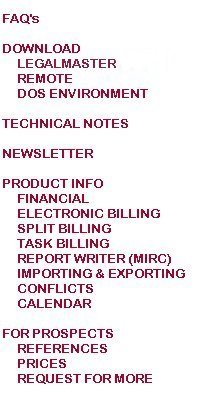


Tell me about Legalmaster's date options.
System date: The date that you supply when you first enter Legalmaster's Main Menu. This date is very important because it becomes the default date for many of Legalmaster's procedures.
Transaction date: The date that you type with each transaction; presumably the date that the event actually took place. This applies to most of Legalmaster's transaction types (Fees, Costs, Payments, Adjustments, Transfers, and Trust).
Entry date: The system date active when you last entered or altered the transaction. This date is not particularly important, although it is useful if you want, for example, to produce a list of all fees typed into the computer on a particular
day.
Cut-off dates: Relevant only to Billing transactions, these two dates are the beginning and ending dates of the fee and cost transactions to be included with a particular billing. The Billing Generator bills all fees and costs whose transaction
dates fall between (inclusive) these two dates. Generally you accept the (1/1/81) default setting for the starting date since you usually want to bill all old unbilled time while you set the ending date to whatever your period closing date happens to be.
Run date or Billing date: The System Date upon which the Billing Generator is run. This date serves two very significant purposes.
How you might use this information
Pre-bills
Generally speaking, Prebills are produced prior to billing. You may, for example, print your pre-bills on March 6th, but only want to review fee and cost data dated through February 28th even though some March time has already been entered into
Legalmaster. Consequently, the date you should care about is the transaction date. By selecting February 28 as your ending transaction date, you are telling Legalmaster to omit from the report the March-dated entries.
The Billing Generator
The Billing Generator, as I'm sure you are aware, is the Legalmaster routine that bills your unbilled time; that is, it credits work-in-process and debits accounts receivable. So again, just as with Pre-bills, your concern is with , transaction dates. By
the time the attorneys have reviewed your Pre-bills, you may be quite a few days into the next billing period. Usually, you would use the same transaction ending date here as you did when you ran your Pre-bills, so that only the time you have had a
chance to review actually gets billed.
The Billing Generator performs three important tasks.
Statements
When you print statements, Legalmaster asks you for a billing ending date. A Statement doesn't care when you did the work; a Statement cares when you billed it. If you ran the Billing generator on May 7th, just be sure that May 7 or later is your billing
ending date. As long as the fee or cost entry was billed on May 7th, regardless of when it was worked, it will appear on the bill. If a fee or cost wasn't billed, i.e., it wasn't included in a run of the Billing Generator, it will not appear on any
statement.
A second date option requested when you print your Statements is captioned transaction ending date. The purpose of this date is to let you limit what payment, adjustment, retainer and trust activity appears on the bill. For example, you ran your Billing
Generator on May 7th with a fee and cost cut-off date of April 30th. As a result, your May fees and costs are not billed and will therefore not appear on your bill. The question here, though, is "do you want payments that you received in May to be
reflected on the bill?" A transaction cut-off date of April 30 tells Legalmaster to omit payments dated after April 30th. A transaction cut-off date of May 7 tells Legalmaster to reflect payments dated through May 7th.
Management Reports
These same date options permeate Legalmaster's management reports. You have access to many levels of information. Once you know what you want, it becomes no more than an exercise in selecting fields and ranges on your MIRC reports.
You may create lists of time entries based upon when they were performed (transaction date), when they were typed into the computer (entry date) or when they were billed (billing date). Since an invoice number is assigned to a fee or cost transaction at
the time that it is billed, you may also use the presence of an invoice number to produce reports of billed or unbilled time. Here are a few examples. All of them would be produced with MIRC for Transactions.
A characteristic unique to MIRC for Revenue Allocation allows you to indicate two date ranges on each column of the report. You may, for example ask to see in one column payments received in June that were applied to billings that took place last year
while the next column shows payments received in June that were applied to this year's billings. Another use of this feature allows you to determine, for example, work performed in January that was billed in April, etc., etc., etc.
This scenario exemplifies Legalmaster's five critical dates. Once you learn how they are used, you can get your reports to address very specific questions.